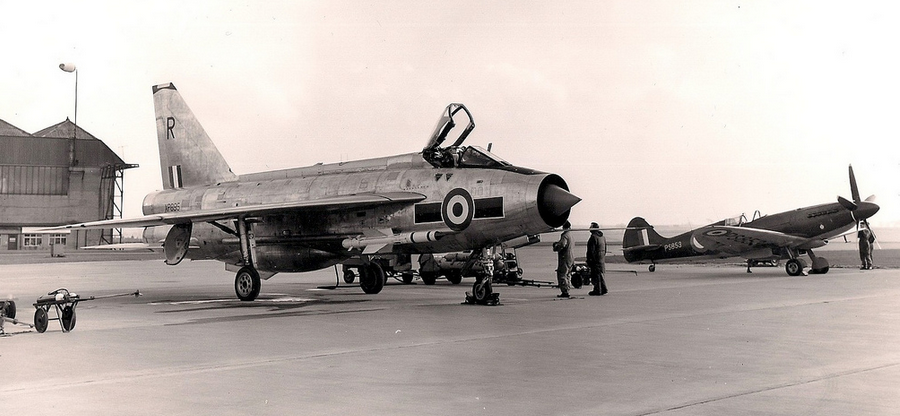“We did find that the piston-engined fighter presented a very poor target to infra-red homing missiles, especially from the rear aspect,” Wing Commander John Nicholls, former Lighting Pilot.
The interesting image in this post shows a Spitfire PR XIX PS853 parked next to an English Electric Lightning Mach 2 fighter plane at RAF Binbrook in 1963.
In that year, PS853 was flown in a series of test flights against Lightnings from Binbrook by Wing Commander John Nicholls, who served as the Officer Commanding the Air Fighting Development Squadron under the Central Fighter Establishment (CFE). He wrote about the reason for these unusual sorties, as well as the flights themselves, in Alfred Price’s 1974 book Spitfire At War (later made available in John Dibbs and Tony Holmes’ book Spitfire The Legend Lives On). He was a veteran of combat in Malaya in the Spitfire XVIII and a MiG killer while on exchange with the USAF during the Korean War.
‘This was at the time of the Indonesian confrontation and, since the Indonesian Air Force operated a large number of P-51 Mustang fighters, we were very interested in discovering how best a Lightning might engage such an aircraft. In the RAF we did not have any Mustangs, but at Binbrook, we did have our Spitfire with a performance that was, in many respects, similar. Thus it came about that our Spitfire came to be involved in a short battle trial pitted against a fighter that was her successor by three generations.
‘Of course, from the start we knew that the Lightning could overtake the Spitfire by nearly 1,000 mph – there was no need to run a trial to prove that. But we did find that the piston-engined fighter presented a very poor target to infrared homing missiles, especially from the rear aspect. And, since the Lightning would therefore very likely have to follow up its missile pass with a gun attack, a high overtaking speed would have made accurate firing very difficult. On the other hand, if the Lightning pilot slowed down too much he could end up playing the slower and more maneuverable fighter’s dogfighting game and lose. None of this was new – we had learned the same thing during trials between the Lightning and the Hunter. Another problem was that if the Spitfire pilot had sufficient warning of the attack he could spin around to meet it head-on – and thus present the most difficult target of all.
‘In the end, we evolved a type of attack that was the antithesis of all I had learned from my own operational experience of fighters-versus-fighters combat over Korea. Instead of trying to get above the enemy and diving on him to attack, we found it best to use the Lightning’s very high power-to-weight ratio to make a climbing attack from behind and below. From that angle the field-of-view from the Spitfire was poor, there was a good chance of achieving surprise and the infra-red source gave the best chance for missile acquisition. If the Lightning pilot did not acquire the target or bring his guns to bear on his first pass he could continue his steep climb – which the Spitfire could not possibly follow – and when out of range he could dive and repeat the process. Using such tactics, we felt that in the end, a competent Lightning pilot could almost always get the better of an equally competent Spitfire (or Mustang) pilot.
‘Almost certainly that trial at Binbrook was the final operational act carried out in earnest in the Spitfire’s long career.’
PS853, which had been completed on September 5, 1944, joined the BBMF in Coltishall, Norfolk, in April 1964. Four years later, it took part in The Battle of Britain filming.
Spitfire The Legend Lives On is published by Osprey Publishing and is available to order here.

Photo by Crown Copyright

